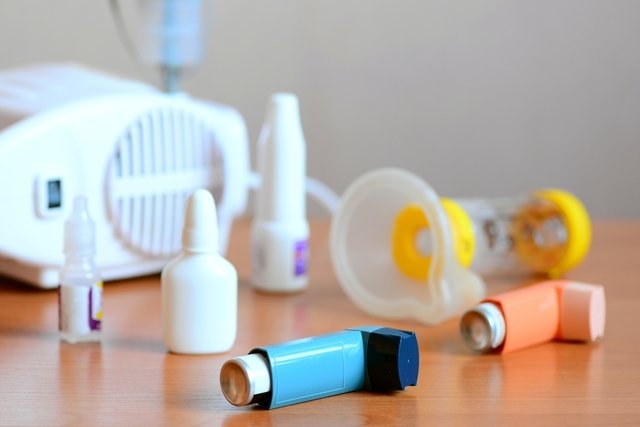Salbutamol is a bronchodilator indicated for the treatment, control and prevention of respiratory diseases that cause spasms in the bronchi, such as asthma, chronic bronchitis or emphysema, as it acts by relaxing the lung muscles, facilitating the flow of air to the lungs.
This medicine can be found in pharmacies or drugstores, in the form of a spray, syrup, tablet, drops or sachets, under the commercial name Aerolin or Aerolin Nebules, but it can also be found as a generic under the name “salbutamol sulfate”, or with the similar names Aerodini or Clenil, for example.
Salbutamol should only be used under medical advice, as it can cause side effects such as tremors, headache or heart palpitations.
What is it for
Salbutamol is indicated for the treatment, prevention or control of respiratory diseases, such as:
- Severe acute asthma;
- Bronchial asthma;
- Asma attacks;
- Chronic bronchitis;
- Pulmonary emphysema
In addition, salbutamol in tablet or injectable form is also indicated for the control of uncomplicated premature birth in the 3rd trimester of pregnancy.
The use of salbutamol should only be done with the advice of a pulmonologist, who can indicate the best form of use, such as syrup, spray, nebulization, tablet or injection, with individualized doses and according to the severity of the symptoms.
Make an appointment with a pulmonologist in the nearest region:
How to use
How to use salbutamol depends on the presentation of this medicine and includes:
1. Salbutamol spray 100 mcg
Salbutamol spray or pump should only be used by oral inhalation. Learn how to use the pump correctly.
The doses of salbutamol spray vary depending on the condition being treated, with a dose of 100 or 200 mcg (1 or 2 doses) being normally indicated for adults for the treatment of asthma attacks or acute bronchospasm, or prevention of bronchospasms caused by physical exercise. or allergy.
For chronic treatment, the normally recommended dose is up to 200 mcg (2 doses), up to 4 times a day, according to medical advice.
For children, the dose of salbutamol spray should be advised by the pediatrician, according to their age and the condition being treated.
2. Salbutamol xarope 2 mg/5mL
Salbutamol syrup 2mg/5mL should be used orally, before or after a meal, by adults or children over 2 years old. The dose of syrup must be measured using the measuring device provided in the packaging.
The normally recommended dose of salbutamol syrup varies with age and includes:
- Adults: the normally recommended dose is 10 mL of syrup, which corresponds to 4 mg of salbutamol, 3 to 4 times a day, according to medical advice;
- Children over 12 years old: the normally recommended dose is 5 to 10 mL of syrup, which corresponds to 2 to 4 mg of salbutamol, 3 to 4 times a day, as instructed by the pediatrician;
- Children aged 6 to 12: the normally recommended dose is 5 mL of syrup, which corresponds to 2 mg of salbutamol, 3 to 4 times a day, as advised by the pediatrician;
- Children aged 2 to 6 years: the normally recommended dose is 2.5 to 5 mL of syrup, which corresponds to 1 to 2 mg of salbutamol, 3 to 4 times a day, as instructed by the pediatrician.
The duration of treatment with salbutamol syrup must be guided by the doctor.
3. Salbutamol drops for inhalation 5 mg/mL
Salbutamol drops 5mg/mL should be used by inhalation, through nebulization, by adults or children, and it is important to dilute the salbutamol drops in saline before use. Learn how to nebulize correctly.
The doses of salbutamol drops for nebulization must be guided by the doctor, as nebulization can be done only when necessary or continuously, and the amount of saline depends on age.
After nebulization, any unused amount of the salbutamol drops solution diluted in saline solution must be discarded.
4. Salbutamol 2 mg or 4 mg tablets
The salbutamol tablet should be taken orally, by adults or children over 6 years of age, before or after food, and with a glass of water.
The normally recommended dose for adults is 1 tablet of 2 mg or 1 tablet of 4 mg, 3 to 4 times a day, according to medical advice.
For children over 6 years of age, the dose of salbutamol tablets should be advised by the pediatrician, according to their age, severity of symptoms and the condition being treated.
5. Salbutamol vials 2.5 mg/2.5 mL
Salbutamol flaconette 2.5mg/2.5mL must be used by inhalation, through nebulization, and it is not necessary to dilute it in saline solution before use. However, the doctor may recommend dilution in saline if a longer nebulization time is necessary.
The doses of salbutamol flaconete for nebulization must be guided by the doctor, as nebulization depends on age, and can be done by adults or children from 18 months of age, and can be done only when necessary or continuously.
It is important to discard any unused amount of salbutamol flaconette after nebulization.
6. Injectable salbutamol 0.5 mg/mL
Injectable salbutamol 0.5 mg/mL is only used in hospitals applied directly to the vein, muscle or under the skin, by a nurse, and the doses must be recommended by the doctor individually according to the problem to be treated and used only in adults.
Possible side effects
The most common side effects that may occur during treatment with salbutamol are tremor, headaches, increased heart rate, palpitations, mouth and throat irritation, muscle cramps, redness, itching, swelling, shortness of breath or fainting.
Salbutamol can cause serious allergic reactions that require immediate medical attention. Therefore, you should stop treatment and seek the nearest emergency room if you experience symptoms such as difficulty breathing, a feeling of a closed throat, swelling in the mouth, tongue or face, or hives. Know how to identify severe allergy symptoms.
Immediate medical attention should also be sought if symptoms such as wheezing or chest pain, irregular heartbeat, sensation of vibration in the chest, constipation, dry mouth, excessive thirst, blurred vision, drowsiness, leg cramps, feeling of numbness appear. , tingling or muscle weakness, increased urinary frequency or, pain or burning when urinating.
The substance salbutamol can also cause doping when the medicine is used excessively and incorrectly.
Who shouldn’t use
Salbutamol should not be used by people who are allergic to salbutamol or any other component of the formula or by people who are using non-selective beta-blockers, such as propranolol.
The salbutamol tablet should not be used to control premature birth in case of threatened miscarriage, nor by children under 6 years of age. Injectable salbutamol should not be used by children, and salbutamol syrup should not be used by children under 2 years of age. Furthermore, salbutamol flaconette for inhalation should not be used by children under 18 months of age.
Salbutamol should not be used by pregnant women, women who are breastfeeding, diabetics, people with poor blood oxygenation or those with hyperthyroidism, without medical advice.
Furthermore, salbutamol should not be used without medical advice in people who are being treated with xanthines, corticosteroids or diuretics.

Sign up for our newsletter and stay up to date with exclusive news
that can transform your routine!
Warning: Undefined array key "title" in /home/storelat/public_html/wp-content/plugins/link-whisper-premium/templates/frontend/related-posts.php on line 12
Warning: Undefined array key "title_tag" in /home/storelat/public_html/wp-content/plugins/link-whisper-premium/templates/frontend/related-posts.php on line 13




